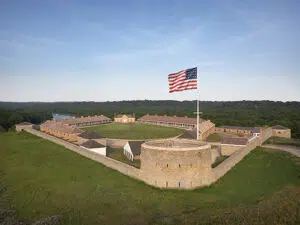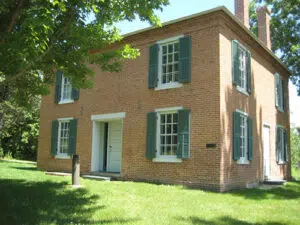Bloomington has a rich and interesting history, starting with when the city was first settled in 1818. Since then, Bloomington has modernized and grown to become Minnesota’s 4th largest city, but you can take a look back at local history with these stops at five notable landmarks.

Historic Fort Snelling
Historic Fort Snelling, Saint Paul
Located at the confluence of the Mississippi and Minnesota Rivers, Fort Snelling was built in the 1820s as a military outpost, and its Round Tower is the oldest building in Minnesota. Visitors can learn about stories from the U.S.-Dakota War of 1862, Civil War, world wars and more. The fort also occupies Dakota homeland, and archaeology and oral history show thousands of years of human habitation in the area.
Mill City Museum, Minneapolis
The museum is housed in the ruins of the Washburn A Mill, once the largest flour mill in the world. Visitors can explore Minneapolis’ flour milling boom along the Mississippi River, including the rise of iconic brands like General Mills and Pillsbury, in the museum’s exhibit. Don’t miss a stop on the ninth floor Observation Deck for a view of the Mississippi and many pieces of city history, including St. Anthony Falls, the Stone Arch Bridge and Pillsbury A Mill.
Pond-Dakota Mission Park, Bloomington
In 1834, brothers Gideon and Samuel Pond arrived in Minnesota Territory from Connecticut as missionaries. The brothers established the Oak Grove Mission in present-day Bloomington in 1843, near Dakota Chief Cloud Man’s village. At the park, visitors can see the original Federal-style brick house that Gideon and his wife Agnes built in 1856.

Pond-Dakota Mission Park
Christ Church Lutheran, Minneapolis
First established in 1911, Christ Church Lutheran is particularly notable for its architecture. The current modernist-style church was constructed in 1949 by famed Finnish-American architect Eliel Saarinen. In 1962, Eliel’s son Eero, the architect of the St. Louis Arch, built the church’s education wing to complement his father’s work. The building was designated a National Historic Landmark in 2009.
Milwaukee Avenue Historic District, Minneapolis
The homes on this two-block historic district in Minneapolis’ Seward neighborhood were originally built as high-density housing for the city’s booming population in the 1880s. Scandinavian immigrants in particular called the area home. In 1970, the Minnesota Housing and Redevelopment Authority planned to demolish the deteriorating homes for urban renewal, but neighborhood residents objected. The area was added to the National Register of Historic Places in 1974. Since then, many of the original homes have been restored, and replica homes have replaced demolished ones.









